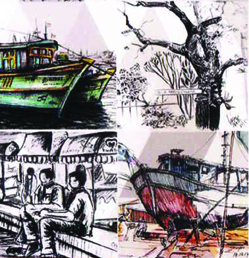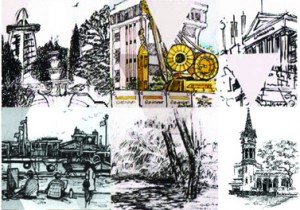Registered with the Registrar of Newspapers for India under R.N.I 53640/91
Vol. XXVI No. 10, September 1-16, 2016
Madras – you are home
by Tulsi Badrinath
 Some of the work displayed (above and below) at the splendid Chennai
Some of the work displayed (above and below) at the splendid ChennaiWeekend Artists’ exhibition during Madras Week.
Madras Week Nostalgia
In Madras, or Chennai, we are simultaneously inhabitants of a neighbourhood with its shrines and local lore as we are to the larger idea of the city.
On August 22nd, 377 years ago, a local chieftain displaying customary hospitality to a guest granted a strip of sandy land to Francis Day of the East India Company.Day was looking for a place to set up a factory and source cheap cotton cloth.That land, comprising a few fishing villages on the east coast of India, secured by Fort St. George and named Madras, became the nucleus of a sprawling nine-million strong metropolis that keeps expanding. The gracious act by chieftain Venkatadri Nayak was the proverbial inch which the East India Company increased to a mile, five villages and then entire kingdoms spreading over the Indian subcontinent.
In the narrative of the founding of Madras are hidden several truths special to the city. We were at once modern and ancient. We were global before the word became fashionable, the waves of the Bay of Bengal connecting us with other continents. In our interactions with people of different faiths, we saw no reason to lose our stability and peace. In our neighbourhoods, we combined the close-knit ties of a village with the urban amenities of a city. And our generosity of welcome remains exemplary to this day.
If commerce formed the basis of the early settlement, bringing travellers from all over the world linking the British with the Portuguese and other Europeans, as also the Armenian traders, their presence only enriched the fabric of faith in the city. Not far from the temple-settlement of Mylapore is the Basilica of Saint Thomas, housing relics believed to be those of the Apostle of Christ. The land for the tank at the Kapaleeswarar temple was gifted by the Nawab of Arcot, a symbol of the amity that exists in the city between different faiths.
The global link continues to this day with the Americans of Ford, the Koreans of Hyundai and the Japanese of Honda fame. Known for the excellent medical care it offers, Madras is the destination of hope for many patients, especially from the West Asia and Africa.
It is this long interaction with people of other cultures that has given Madras its ability to absorb the modern, the new into its way of life that is grounded in solid tradition. At the same time, it is unafraid to embrace radical thinking of political and social reform along the lines of the Self-Respect Movement.
While outwardly the Gregorian calendar marches on, the city keeps its compact with a timeless Tamil calendar that is based on agrarian and lunar cycles. Full-moon nights are special, as is the harvest festival of Pongal. We fear the evil eye here as much as we do the dreaded rahu kaalam, when time is not in our favour. The just-passed month of Aadi is devoted to the Goddess and the coming of the monsoon. In the special month of Margazhi, which falls mid-December, roads and lanes are converted into canvases of tar when giant kolam-patterns are drawn daily with rice flour, some spreading across the entire width of a street. More than two thousand concerts of classical music and dance are offered to the gods in this most celestial of months.
When the city of Madras expanded outwards from the 100-acre nucleus of Fort St. George, it did so by aggregating villages into its outer limits. The local histories of these villages go back centuries, and there is a very strong link via customs to these origins. Here, we are simultaneously inhabitants of a neighbourhood with its shrines and local lore as we are to the larger idea of the city.
Adyar, for example, the area I have lived in most of my life, has its own rich history and even ecological and geographical features unmatched by other areas. It takes its name from the river Adyar that widens into an estuary before flowing into the sea. On one bank, a swanky cluster of high-rise apartments, very Nariman Point – and on the other, the dense wooded calm of the Theosophical Society. This view symbolises to me the old of Chennai and the new of Madras.
It is in walking down the streets and alleys of localities that you savour the many delights of Madras. Hot idlis and fresh chilli bhajjis made in the numerous food carts on the streets; tender coconut water spurting at the flash of a sickle; jasmine flowers sold by a very human unit of measurement: the flower seller’s fore-arm; fresh-from-the-sea vanjaram fish-fry; tea and biscuits at the stall.

Closer home, the fragrance of filter coffee wafts from the kitchen three houses away. I can tell the time of day by my neighbour’s coffee-drinking habits. Two houses away, an octogenarian plays the flute every evening, stubbornly coaxing notes from bamboo. Next door, the sound of retching announces a pregnancy faster than words. As in a village, no one’s life is private. No one is anonymous either. And perhaps it is this quality that makes Madras truly special. We know our neighbours.
In the mad rush of daily existence, we might sometimes forget to demonstrate this fact. But it only takes a disruption such as a power-cut, a tsunami or the recent floods of November and December 2015 to remind us of our ties to the local community. Of the many tales of adventure and survival that were told after the floods, the dominant narrative was one where people, whether neighbours or strangers, came together to help.
I heard the most touching story of a small-time building contractor who risked his life to help an elderly, cantankerous bachelor to safety, even though days earlier he had been on acrimonious terms with him for being paid too little. It is this spirit that makes those who left to live elsewhere still return to Madras, year after year. It is this that makes us, who live here by choice, call it home.
A Mylapore landmark that’s no more
In the context of Madras Week celebrations it might be of interest to recall a Mylapore landmark that has disappeared without a trace.
It was once a unique part of an integrated supply chain and was much ahead of its time for its linkage, design and practical utility. I refer to the Thannithurai Market. Thannithurai in Tamil translates as ‘waterfront harbour’.
I was in P.S. Secondary School, between 1940 and 1944, and would watch boatloads of grain, vegetables, fish and fruit arriving at the waterfront on the Buckingham Canal. As the canal was just by the side of the school, the latter even came to be referred to as Kaavaakkarai School – ‘canal side school’. To us boys having seats near the windows on the western side of classrooms, the spectacle of unloading and reloading was more riveting than the class proceedings. We were told that the cargo came by this canal all the way from Bunder, 300 miles away, in present day Andhra Pradesh. Bunder was another name for Masulipatnam, Masula for short. The cargo discharged from the boats was re-loaded on to push carts and moved manually for just less than a furlong (‘furlong’, was the term used then for 220 yards or the equivalent of 200 metre or so) to wholesalers having covered stalls and storage spaces in the Thannithurai market adjacent to the present day Hanuman Temple.
The wholesalers were, imaginatively, placed on the eastern half of the market premises, nearer the water front, and the retail stalls were located on the western half with entry from the present road leading to Luz. Competition was fierce, given the large number of retailers – each retailer soliciting custom by promising fresher material at lower prices and correct weights!
The market itself was a sprawling area, but of a simple single level comprising raised platforms with tiled roof. The unit measure was a veesai, weighed out by hand-held balances. The weighed quantity could be manipulated by a deft pressure one side or the other of the holding hand. The weights bore certification stamps but the bottom of each weight could also be scraped out to remove some of the metal to give a lower weight. Karuveppilai (curry leaves) and Kothamalli (coriander leaves) were given gratis to those bought major items.
My mother armed with me enough knowledge on how to test good quality from bad, on bargaining strategies and on how not to get outwitted on weights! It was my duty in the house to procure vegetables from Thannithurai twice a week. I used to cycle with two jute shopping bags hanging on either side of the handle-bar of the cycle and return home laden with both bags full. I would also bring back a few annas (each anna was six present-day paise) out of a mighty sum of two rupees that my mother gave me while cautioning me to keep it secure and not let it drop on the wayside.
The power of money, the simplicity of life and the fantastic concept of a supply chain linked by a cheap mode of transport, that the waterway was, are the only memories left of this bygone era. The Thannithurai Market space is now occupied by a high-rise apartment complex with no trace whatsoever of a fine local but great institution.
-N.S. Parthasarathy

